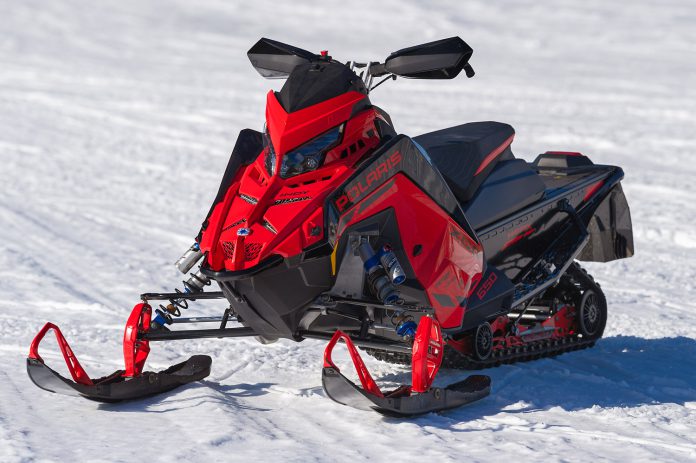The XCR moniker has been in play for literally decades. The early years of XCR saw the legendary Indy, all-aluminum, trailing arm chassis rule terrain and sno-X racing in the early 90’s. The sled was incredibly light, had steering and suspension geometry developed in the ditches around Roseau – and beyond. The sled flew like a Cessna and consumed terrain with a venomous appetite.
Those original Indy XCR’s were powered by Fuji 440cc piston port twins until when early in Polaris’ domestic engine program, the company released a Liberty 440 twin with read valve induction and torque-generating exhaust valves. Throughout the early and mid 90’s, the XCR was the benchmark for terrain-consuming prowess.
Yes, Cat’s ZRs were potent and Ski-Doo was making huge cred gains in the Midwest with the MX-Z – first in the “S” chassis then in the “ZX” platform. Those times were the roots of Polaris’ terrain racing success. In those days the XCR was the archetypical racing snowmobile – and everyone knew it.
Fast forward to today’s marketplace and witness the XCR, circa 2021. The current MATRYX chassis now carries the XCR’s legendary trademark and it does it with credibility and legitimacy. I could spend the rest of this report discussing the MATRYX XCR’s compression and rebound adjustable Walker-Evans 2.0 racing shocks, the billet rear scissor stops, the oversized racing brake rotor and bigger caliper along with high performance brake pads and the legendary XCR brake air scoop. But I won’t.
PATRIOT POWER – XCR PROWESS
This time around it’s all about the XCR’s ultra-potent Patriot 650 twin. In my humble opinion, the 650 speaks to the roots of what XCR really STANDS FOR. Sure, there’s an 850 XCR – and it is a cannon. However, the XCR is about ditch banging, technical rough terrain navigation and telepathic corner carving on the twistiest trails known to man.
To navigate this kind of terrain you need power that’s torquey, seamless and explosive at the big end. You need an engine that’s much more than the sum of its parts. Literally you need a 650 that thinks it’s an 850. That, my friends, is exactly what you get with the new Patriot SDI 650.
650 OR 600?
Of course, the most important comparo we made last season was the Patriot 650 versus the benchmark Rotax 600R. There was little surprise when the Polaris 650 pulled the Rotax 600 in both low speed throttle roll-ons and WOT runs down the lake.
Frankly, it would have been pretty disappointing if, after benchmarking the Patriot 650 against the then king of the 600 class, the Rotax 600R, the 650 was slower than the 600R. The reality is that 650cc’s just makes more power than 600.
The Ski-Doo 600R, according to everything we’ve heard swirling about the industry, makes just shy of 130-hp. Polaris doesn’t produce a horsepower claim for the Patriot 650 but informed observers pretty much agree its HP is in the 137 to 140 range. That number is a big step up from 50cc bigger holes. Think about this: It was only a few years ago a full-on 800 delivered about 150-hp – some less.
MORE THAN RAW POWER
A feature we are standing and applauding is the Patriot’s radically revised engine mounting system. Eliminating the age-old, vibration-inducing torque stop keeps the 650 in perfect alignment with its clutches. The difference in hood, windshield and handlebar shake is remarkable. This is the same system used on the 850. Its lack of vibes brings a tangible aura of sophistication and refinement.
There’s little doubt a legion of XCR aficionados will go gaga over the new XCR 650 in either 128 or 136 inch variants. The sled feels nimble in turns and transfers nicely when the loud handle is whacked. The precise and linear delivery of power flows seamlessly through proven clutches into white top.
Because the new MATRYX presents what we believe to be the very best ergonomics in the industry today, you’ll find yourself “thinking” your way through twisty trails. It’s a good feeling to know you’re in the right place aboard your sled when clearing approaches or running a mogul infested portage.
That’s the sense the MATRYX XCR 650 delivers. In fact, this kind of control will likely make you a better rider. Seriously.








